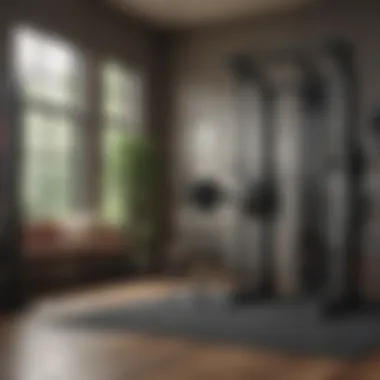Top Compact Home Gym Solutions for Small Spaces


Intro
In the age of customization and limited living spaces, compact home gyms have emerged as a beacon of opportunity for fitness enthusiasts and casual exercisers alike. With a global shift towards healthier lifestyles, many individuals find themselves looking for effective ways to keep fit without the need for expansive equipment or dedicated workout rooms. The idea is simple yet powerful: maximizing your workout potential while benefiting from efficiency and cost-effectiveness. As such, this exploration scrutinizes various compact gym solutions that cater to this growing need.
The shift towards home workouts sparked a surge in demand for fitness products that offer versatility and functionality. No longer is having a gym membership the only way to achieve fitness goals; rather, investing in high-quality home equipment allows for flexibility around busy schedules. Compact gyms come in various forms, from all-in-one setups to free weights and resistance bands, each designed to deliver a comprehensive workout regime without monopolizing precious space.
These home gym options not only provide a workout space but also symbolize a lifestyle commitment to wellness, particularly in times when health has taken center stage in our lives. This abstract sets the stage for navigating the myriad choices available, guiding readers toward making informed and optimistic decisions about their fitness journeys.
Prologue to Compact Home Gyms
The rise of compact home gyms marks a significant shift in the fitness landscape, particularly for those navigating the challenges of limited living spaces. Compact gym solutions offer an attractive alternative to traditional large-scale fitness setups, allowing individuals to pursue their fitness ambitions without sacrificing valuable square footage. This article aims to dissect the various facets of compact home gyms, revealing the multifarious benefits, types of equipment, and essential features one should look for when selecting the best option.
Defining Compact Home Gyms
In essence, compact home gyms are fitness systems designed to maximize functionality while minimizing required space. Unlike conventional gyms that boast an extensive array of machines and weights, compact variants are streamlined. They encompass everything from all-in-one systems that allow for multiple exercises to portable gear like resistance bands and small free weights.
To define a compact home gym, consider these key attributes:
- Space-saving design: Equipment should occupy limited areas without compromising the range of motion.
- Multi-functional: A single piece of equipment often accommodates various workout modalities, from strength training to cardio.
- User-friendly: Easy assembly, operation, and storage options that didn't require a PhD in engineering.
Understanding these metrics sets the baseline for evaluating the best compact home gym options available.
The Growing Popularity of Home Workouts
Today, the trend of home workouts has found its stride, catalyzed by factors such as convenience, safety, and the ever-elusive idea of customizing one’s fitness journey. The rapid adoption of digital fitness solutions—like workout apps and video tutorials—has enabled diverse audiences to pursue regular exercise without entering a conventional gym. This shift makes compact home gyms even more pertinent.
A few notable points fueling this growth include:
- Comfort of Home: Many find a sense of ease exercising in the privacy of home versus a crowd-filled gym.
- Time Efficiency: Skipping the commute is a massive boon. Just roll out of bed instead of fighting rush hour traffic.
- Tailored Fitness Experiences: Users can create workout schedules that fit their lives, with no need to adjust around gym hours or classes.
Ultimately, these points illustrate how compact home gyms align seamlessly with current lifestyle trends, leading individuals not just to stay fit, but to thrive. The continuous evolution of workout practices informs a steady growth in the compact gym market, paving the way for innovative equipment solutions.
Benefits of a Compact Home Gym
As the modern world continues to shift towards remote work and lifestyle changes, the idea of maintaining health at home has gained momentum like never before. Compact home gyms offer a versatile solution to those looking to integrate fitness into their daily lives, especially when space is at a premium. Understanding the benefits of a compact home gym is paramount for anyone considering this investment. They not only foster an environment for physical activity but also align with practical needs. Let's explore key benefits that make these gym setups so appealing.
Space Efficiency
With urban living on the rise, many find themselves crammed into smaller spaces. Space efficiency is the name of the game when it comes to compact home gyms. This isn’t just about squeezing a piece of equipment into a corner; it’s about smart organization. High-quality, compact setups can provide a full workout experience without requiring the footprint of a traditional gym. Things like folding benches or multi-functional stations ensure that you can exercise effectively while keeping your living area tidy.
Moreover, compact equipment often has clever designs that enable easy storage and usability. For instance, adjustable dumbbells can replace an entire set without taking up valuable square footage. This means that you can transform any corner of your home, be it a living room, bedroom, or garage, into a personal fitness space. When thinking about space management, consider options that maximize utility while minimizing your physical footprint.
Cost-Effectiveness


Investing in a home gym can seem daunting, especially with the wide array of options available. However, compact home gyms tend to offer significant savings in the long run. Membership fees for gyms can quickly add up, especially if you’re in a bustling city where prices are effectively through the roof. By choosing a compact setup, you make a one-time investment that pays off over time.
Consider not just the initial costs, but the flexibility that comes with having your own gym. You can work out whenever you like—no more rushing to catch class times or dealing with overcrowded spaces. Plus, many compact options come equipped with various features, eliminating the need to purchase additional gear. Keep an eye out for all-in-one systems that combine strength and cardio options, as these can provide the biggest bang for your buck.
Convenience and Flexibility
In terms of convenience, the advantages of a compact home gym are hard to overstate. Imagine waking up in the morning and being able to roll out of bed and into your workout routine without needing to travel to a separate location. This drastically improves adherence to a fitness regimen, as it eliminates barriers like travel time and forgetting essential gear. You can easily incorporate exercise into your busy schedule.
Moreover, the flexibility offered by compact gyms cannot be overlooked. Many individuals have different fitness goals, whether it's building strength, improving cardiovascular health, or practicing yoga. A compact setup allows flexibility in training styles, enabling you to adjust your regimen based on energy levels, time constraints or simply how you feel on any given day. This dynamic allows users to stay engaged without monotony creeping in.
"A compact home gym not only aligns with your physical space but also your lifestyle, making fitness a seamless part of your daily routine."
By appreciating these key benefits—space efficiency, cost-effectiveness, and the convenience of accessing workouts at your leisure—anyone can see the immense value in compact home gym options. These attributes make them not just a trend, but a sustainable choice for many health-conscious individuals.
Key Features to Consider
When it comes to compact home gyms, several key features play a vital role in your decision-making process. These features directly impact the ability, safety, and overall experience you’ll have while working out at home. Understanding the significance of these elements can save you from making costly mistakes in your equipment choices. It’s like picking out the right tools for any job; the right equipment can make or break your home fitness journey.
Versatility in Workouts
Versatility is perhaps the crown jewel of any workout setup. When selecting compact gym equipment, you want to ensure that it allows for a variety of exercises. A versatile gym gives you the freedom to target different muscle groups without the need for multiple pieces of equipment cluttering your space. This might include all-in-one machines that offer functionalities like strength training, cardio, and flexibility workouts all under one roof. Imagine having the power to switch from bench presses to leg curls with minimal effort.
Investing in gear that promotes this range not only keeps your workouts fresh, but also encourages you to keep exercising regularly. Variety can be the secret ingredient to ward off workout plateaus and monotony. After all, who wants to feel like they're stuck in a routine?
Adjustability and Customization
Adjustability in your home gym is crucial, especially if multiple people will use the same space. Customizable equipment is ideal as it can cater to different heights, strengths, and fitness levels. A good example is adjustable dumbbells or bench press sets that can easily transition from beginner level to advanced habits. The ability to tweak resistance settings, heights, or angles means that you can progressively challenge yourself without outgrowing your equipment.
Moreover, customization adds a personal touch. Whether you're trying to build bulk or tone up, having control allows you to modify your routines to meet your specific goals. A well-set system is like a tailored suit; it fits just right, providing you the freedom and comfort to perform at your best.
Durability and Quality Materials
Durability is another cornerstone you should not ignore. The longevity of gym equipment often correlates to the type of materials used in its construction. Investing in high-quality equipment can save you both money and hassle in the long run. You want to ensure that the metal frames, plastics, and stitching on your equipment can endure wear and tear from intense workouts.
Consider these factors when evaluating the durability:
- Material Type: Steer clear of cheap plastic components. Instead, look for metals and heavy-duty materials that promise longevity.
- Warranty Length: A longer warranty often signifies that the manufacturer has confidence in their product's durability.
- User Feedback: Sometimes, the best insights come from those who've walked the walk. Look for reviews that mention durability and maintenance issues.
Durable gym gear can withstand rigorous training regimes, ensuring your investment pays off with time.
"Opting for quality over quantity at the start can provide a far more rewarding fitness experience in the long run."
In short, the right features in your compact home gym can greatly enhance your workout experience, making your home a sanctuary for fitness and health.


Types of Compact Home Gym Equipment
When considering creating an effective home gym, understanding the types of compact gym equipment becomes crucial. This not only allows for a variety of workout options but also ensures that your space is utilized in the best possible way. Choosing the right equipment can make or break your home fitness journey. With the rise of home workouts, having compact, yet powerful, options is more pertinent than ever.
Evaluating the Best Options of
When considering compact home gym equipment, it's essential to evaluate options that suit unique fitness needs and environments. This section provides a roadmap, making it simpler to navigate through various products that are available in 2021. In the age of home workouts, picking the right gear isn't just about buying what looks good; it’s about functionality, adaptability, and performance.
A crucial part of this evaluation process involves understanding how different equipment aligns with individuals' fitness goals, space limitations, and lifestyle preferences. Here, we'll examine major categories, dissect customer insights, and conduct a thorough price analysis. Collectively, these elements paint a complete picture for potential buyers, simplifying what can often be a daunting decision-making process.
Top Picks by Category
Breaking down choices into categories can help zero in on what best suits your personal workout routine. Some top picks for compact home gyms in 2021 include:
- All-in-One Home Gym Systems: Machines like the Bowflex PR3000 offer multiple functions without hogging space. They're popular for those seeking variety in their workouts.
- Adjustable Dumbbells: Brands such as PowerBlock or Bowflex SelectTech create flexible resistance training solutions that save considerable room without sacrificing utility.
- Resistance Bands: Lightweight and easily stored, bands from companies like Theraband or WOD Nation are essential for any home gym enthusiast.
- Cardio Equipment: Compact treadmills like the LifeSpan TR1200-DT3 and folding exercise bikes from brands such as Exerpeutic have gained traction for their space-saving aspects.
Each category has its own strengths and payout based on how well it integrates with varied workout routines. Potential buyers should focus on both immediate fitness requirements and future goals while looking at these top picks.
Customer Reviews and Expert Opinions
Understanding what users and experts have to say about specific home gym options can guide informed choices. Overwhelmingly, reviews focus on accuracy, durability, and the user experience.
- Ratings: Look for products with a rating of at least 4 out of 5 on popular retail sites. These often signify that the gear satisfies most users’ expectations.
- Expert Recommendations: Fitness trainers often recommend gear based on actual user experience. For example, a noted fitness coach may advocate the compact Peloton bike for its performance and community engagement, although it comes with a premium price.
- Real-Life Feedback: Many users mention the importance of versatile equipment. Comments like, "I can do both strength and cardio on my compact gym setup" indicate a growing preference for products that provide multifunctionality.
Collectively, these insights shape consumer expectations and can highlight features that may not be immediately visible in product descriptions.
Comparative Price Analysis
Price points can greatly influence decision-making when looking for compact home gym equipment. A comparative price analysis allows potential buyers to weigh the function against budget:
- Entry-Level Options: Equipment such as resistance bands typically starts around $20. This is an excellent option for beginners or those on a tight budget.
- Mid-Range Choices: All-in-one systems can range from $300 to $1,000, depending on the features and brand reputation.
- Premium Equipment: Higher-end models, like the Peloton bike, can go north of $2,000 but come with enhanced technology and support.
Conducting thorough research on pricing helps set realistic expectations, ensuring users do not overspend on features they might not utilize fully.
"Knowing what the market offers at various price points can save you both money and frustration in the long run.”
Tips for Creating an Effective Home Gym Space
Creating a home gym isn’t just about buying equipment; it's about fostering an environment that promotes consistency and motivation. A well-thought-out home gym can enhance your workout experience, making it more enjoyable and effective. With limited space in many homes, there’s a need to optimize every square inch. Creating a dedicated space for fitness reflects a commitment to health and well-being, catering to your unique lifestyle and preferences.
Optimizing Space Layout
When it comes to layout, it's all about balancing functionality and accessibility. You want to ensure that everything is within arm's reach yet neatly organized to prevent clutter. Here are some essential considerations:


- Determine Your Equipment Needs: Identify what equipment you'll use most. If you prefer strength training, prioritize space for weights and benches. If cardio is your jam, consider a compact treadmill or stationary bike.
- Designate Zones: Create distinct areas for different types of workouts. Perhaps one corner is for strength training while another houses cardio equipment. This zoning can mentally prepare you for specific routines.
- Utilize Vertical Space: In smaller rooms, vertical space is your best friend. Wall-mounted panels for bands or hooks for weights can save floor space. Shelves can also store your accessories without taking up too much room.
- Ensure Flow: Make sure there's enough space to move freely. You don’t want to cramp your style while doing jumping jacks or lunges. Leaving a few feet of open space can provide room for a full range of motion.
"Being able to easily access equipment can dramatically reduce the friction of starting your workout, which often leads to consistent exercise habits."
Incorporating Additional Accessories
Accessories play a big role in diversifying your workouts and challenging your body in new ways. Here are some essential elements to consider:
- Resistance Bands: They come in various strengths and can enhance strength training exercises while being incredibly space-efficient.
- Yoga Mats: Ideal for stretching, core workouts, or yoga routines. A good mat can create a comfortable surface while adding an element of grip for floor exercises.
- Foam Rollers: Essential for recovery and muscle maintenance. They can fit neatly into a corner or be stored under a bed, making them convenient yet unobtrusive.
- Storage Solutions: Invest in bins or baskets to keep smaller items organized. Nobody wants to trudge over dumbbells or yoga blocks.
By implementing these strategies, you create not just a space to work out but a zone that inspires better health and vitality. Optimizing your layout and choosing the right accessories can transform an ordinary space into a sanctuary for fitness enthusiasts.
Incorporating Technology in Home Workouts
In today’s fast-paced world, integrating technology into home workouts has become as commonplace as a morning coffee. The impact of gadgets and apps on fitness routines is undeniable, transforming the way people perceive exercise. While compact home gym equipment is crucial for physical conditioning, technology takes it to another level by providing resources that promote better practices, motivation, and accountability. As we navigate through the options available in 2021, understanding how to leverage these tools becomes vital for maximizing results.
Fitness Apps and Digital Resources
Fitness apps have become the backbone of many home exercise regimens. Not only do they offer workout plans tailored to various fitness levels, but they also track progress, making each session more impactful. Consider the sturdiness of popular apps like MyFitnessPal or Strava. They help users maintain awareness of their routines, how much they’ve moved, and where they can improve. With a few taps, individuals can find meal plans, and coaching advice, and even link to social networks for community support.
Benefits of Fitness Apps:
- Customized Programs: Users can input their goals, be it weight loss or muscle gain, and the apps churn out tailored workouts accordingly.
- Progress Tracking: Charts and graphs provide visual representations of gains over time, keeping motivation high.
- Community Connection: Many apps incorporate features for sharing accomplishments with friends or viewing challenges, which helps create a sense of belonging.
Additionally, there are digital resources like YouTube channels and online courses. These platforms enable users to follow alongside instructors, which is invaluable when trying to master specific moves or techniques.
"The best part of tech in workouts? You choose who guides you. It can be like having a personal trainer in your pocket!"
Wearable Fitness Technology
Wearable tech is narrower in scope but might pack a punch on personal insights. Devices like Fitbit and Apple Watch monitor heart rates, steps taken, and even sleeping patterns. This rich data tapestry can tell a story of a user’s overall health that no standard gym equipment could reveal.
Considerations for Wearable Tech:
- Real-Time Feedback: During workouts, it provides feedback on performance, urging modifications when necessary to prevent injuries.
- Long-Term Health Insights: Users can observe trends over weeks or months that reflect lifestyle and fitness progress.
- Integration with Other Tech: Many wearables sync with fitness apps, creating a seamless experience that combines multiple aspects of personal health.
As the fitness landscape continues evolving in 2021, the intersection of technology and home workouts is shaping up to be one of the most important pillars of effective exercise. By embracing these digital innovations, fitness enthusiasts can amplify their home workout efficiency, ensuring that their routines do not just exist in isolation but are part of a larger strategy for health and wellness.
End and Recommendations
When it comes to compact home gyms, the right choices can make all the difference in your fitness journey. This section draws together all the threads we’ve explored throughout the article, providing you with actionable takeaways and considerations for your personal workout space.
Summarizing the Key Insights
From evaluating the benefits of space efficiency to understanding the flexibility of compact home gym options, several factors emerge as critical in selecting the best fitness equipment for your needs.
- Prioritize Equipment Versatility: Look for systems that allow for a range of exercises. An all-in-one home gym, for example, can offer strength training, cardio, and flexibility workouts, all in one compact package. This not only saves space but also aids in maintaining a varied workout routine, essential for keeping boredom at bay.
- Consider Quality and Durability: In a world where quick fixes can be tempting, opting for high-quality equipment pays off. Investing in durable materials ensures that your home gym can withstand daily use without falling apart after a few months.
- Understand Your Space: Measure your available space before purchasing any equipment. Compact doesn’t mean cramped, so ensure there’s enough room for you to move freely while working out. Folding equipment can be beneficial when you're short on space, allowing easy storage when not in use.
- Budget Planning: Set a budget before diving into equipment selection. Often, home gym essentials such as resistance bands and adjustable dumbbells can provide significant functionality without breaking the bank. Remember, just because a piece of equipment has a hefty price tag doesn’t mean it will serve you better.
- Tech Integration: Lastly, consider how technology can enhance your workouts. Fitness apps, virtual coaching, or smart dumbbells can add a layer of engagement and accountability to your routine. Moreover, adopting new fitness tech trends can keep you motivated and informed about your progress.
"The convenience of a compact home gym not only transforms fitness routines but also fosters a sustainable lifestyle shift toward health and wellness."
In summary, the evolution of home workouts has paved the way for an exciting array of compact home gym options. The key is to focus on equipment that aligns with your workout style, available space, and budget, ensuring that your fitness endeavors do not get lost in the clutter. By making informed decisions based on the insights shared, you can cultivate a productive fitness environment that empowers you on your wellness journey.







